Java Moss 101
Java moss is a popular aquatic plant that has become a staple in the aquarium hobby. It’s a versatile and hardy plant that can be used in various ways, making it a great addition to any aquarium setup. This comprehensive guide will explore the benefits of Java moss, how to care for it, and how to incorporate it into your aquarium.
What is Java Moss?
Java moss, also known as Taxiphyllum Barbieri, is native to Southeast Asia. It is a slow-growing plant found on submerged rocks, trees, and other surfaces in the wild. Java moss is a popular plant for aquariums because it is easy to care for and provides many benefits to both the shrimp and fish in the aquarium.
Java Moss is a small, delicate plant that forms a dense, lush, and carpet-like growth. It has tiny, bright green leaves that grow randomly and irregularly, creating a distinctive and attractive texture. The leaves are usually only a few millimeters in size and increase in a tangled mass, giving the plant a soft and velvety appearance. Java Moss does not have any stems or roots. Instead, it attaches itself to rocks, driftwood, or other surfaces using tiny, fine threads called rhizoids. The plant can grow several centimeters in height, but it is typically much shorter, only reaching a few millimeters in size. Overall, Java Moss is a unique and attractive plant that adds a touch of natural beauty to any aquarium.
Mosses are a diverse group of non-vascular plants, meaning they don’t have a vein-type structure to transport nutrients or produce any flowers or seeds. There are approximately 12,000 species of mosses found worldwide, ranging from tropical rainforests to arctic tundras. Mosses can be found in various habitats, including forests, meadows, wetlands, and even on rocks and tree trunks. Some moss species are aquatic and can grow in freshwater habitats, while others are terrestrial and grow on land. Overall, mosses play an essential role in many ecosystems.

Benefits of Java Moss
There are many benefits to adding Java moss to your aquarium. Some of these benefits include:
- Providing a natural and attractive appearance: Java moss adds a lush, green look to your aquarium and can be used to create a natural, peaceful environment.
- Improving water quality: Java moss helps to filter the water in your aquarium, removing harmful chemicals and pollutants.
- They provide a haven for shrimp and fish, which offers them a safe place to hide and feel secure, reducing stress levels and improving their overall health.
- Enhancing breeding success: Java moss provides a surface for fish to lay their eggs in and around and can also help protect them from other fish in the aquarium.
- Increases the overall grazing area, which is very important for shrimp keeping.
- It can be grown in hard and soft water.
How to Care And Grow Java Moss
Java moss is a low-maintenance plant that is easy to care for. Here are some tips for keeping your Java moss healthy:
- Lighting: Java moss does not require intense lighting and will grow in low-light conditions. However, it does need some light to survive, so provide it with low to medium light.
- Water temperature: Java moss is not picky about water temperature and will thrive in a range of temperatures, from
- 68°F / 20°C to 82°F /28°C
- Water flow: Java moss does not like strong currents, so make sure to provide it with a gentle water flow.
- Fertilization: Java moss does not require fertilization, but if you want to promote faster growth, you can add liquid fertilizer to the water.
Propagating Java moss
Java moss is a highly propagable plant that can be easily grown and maintained in an aquarium. Several methods for propagating Java moss include tying it to a substrate, allowing it to grow free-floating, or growing it emersed outside the tank in a tub or container.
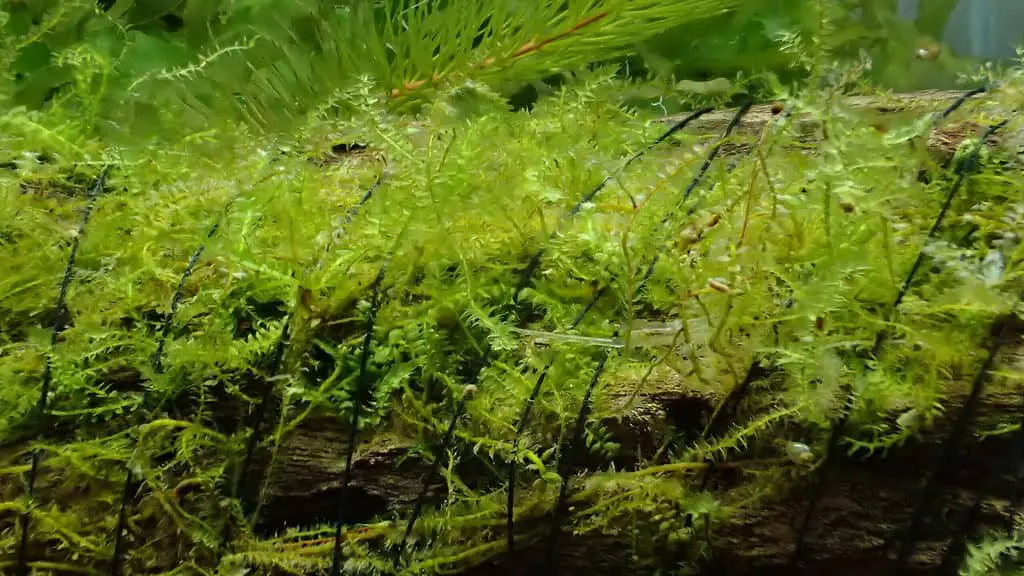
Tying to a Substrate/ Wood
One of the most popular methods for propagating Java moss is to tie it to a substrate, such as wood or stainless steel mesh. This method allows the plant to attach to the substrate and grow into a lush, green carpet. To tie Java moss to a substrate, wrap it around it and secure it with a fishing line, thread, or a rubber band.
I like to use cotton thread in black or green for my projects as those colors fit in naturally with the appearance of the aquarium. I use cotton as; eventually, it rots away to nothing.
You can also use super glue to attach moss, but I’ve never liked the way it looks in the tank once it sets and turns white, eventually the moss, over time, will break away from what it was attached to, and you are left with a white mark, which isn’t so pretty in a planted tank.
I have also, in the past, used rubber bands to attach moss, and while it’s a very fast way to do it, I’ve found that the rubber eventually rots and disintegrates.
I hope you can get the gist of where I am going with my advice above. I think it’s always better to use a natural product in a shrimp tank that can disintegrate over time and have no ill effects on the shrimp or fish.
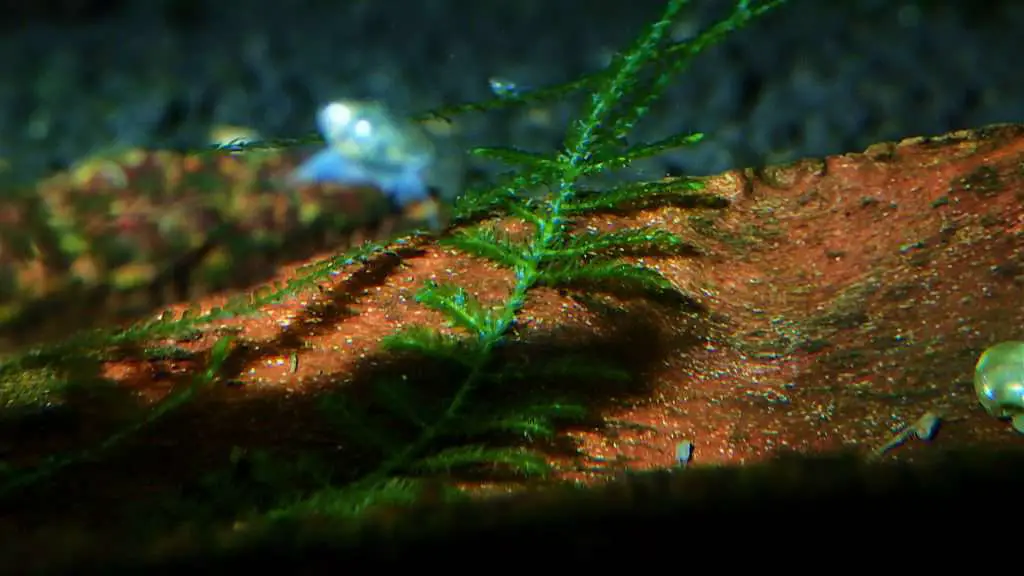
Free-Floating
Another method for propagating Java moss is to allow it to grow free-floating in the aquarium. This method is ideal for those who want to create a natural, floating mass in their aquarium. Simply add a piece of Java moss to the aquarium and allow it to float freely. Over time, the plant will grow and spread, creating a lush and attractive floating carpet.
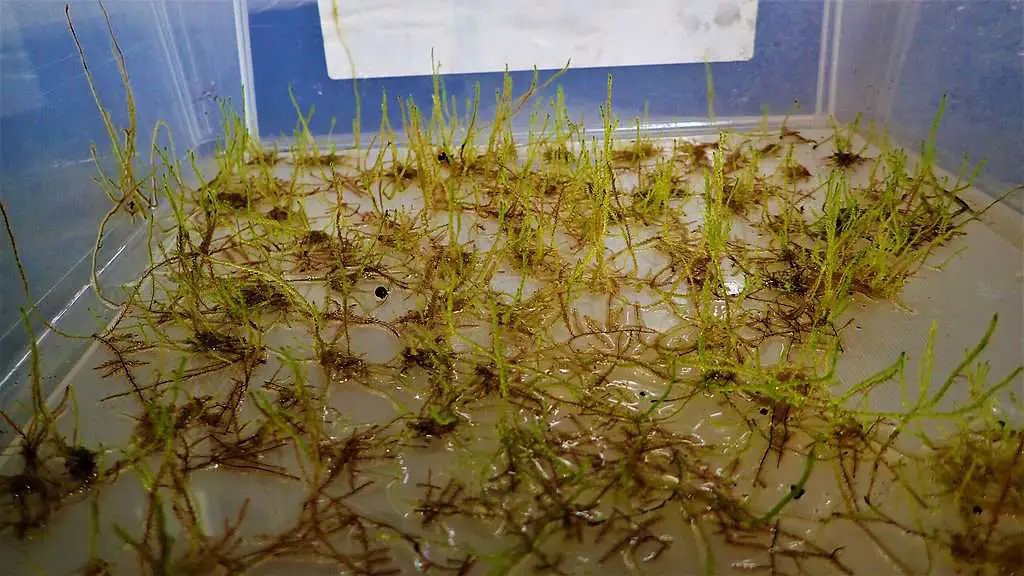
Growing Emersed
In addition to growing in an aquarium, Java moss can also be grown emersed in containers misted with water a few times a day. This method is ideal for those who want to propagate large quantities of Java moss or for those who want to grow the plant in a controlled environment.
Place the Java moss in a container and mist it with water several times daily. Over time, the plant will grow and be used in an aquarium.
You can also use hydroponic fertilizers in this setup, but make sure that you don’t leave any emersed plant sitting in lots of standing water because all you will end up with is an algae farm.
I would also suggest you get your lights on timers and get them on for as long as possible within reason. I have mine on for 12 hours a day right now.
Creating A Java Moss Wall
You can use Java moss to create a wall or carpet in your aquarium. This is a great way to provide a natural look and offer fish a place to hide. I made one here you can take a look at.
To create a wall, you must finely cut the moss and spread it across your chosen substrate. To make a java moss wall, you need to attach it to something it can hang from standing upright. I have used plastic canvas before with great success.
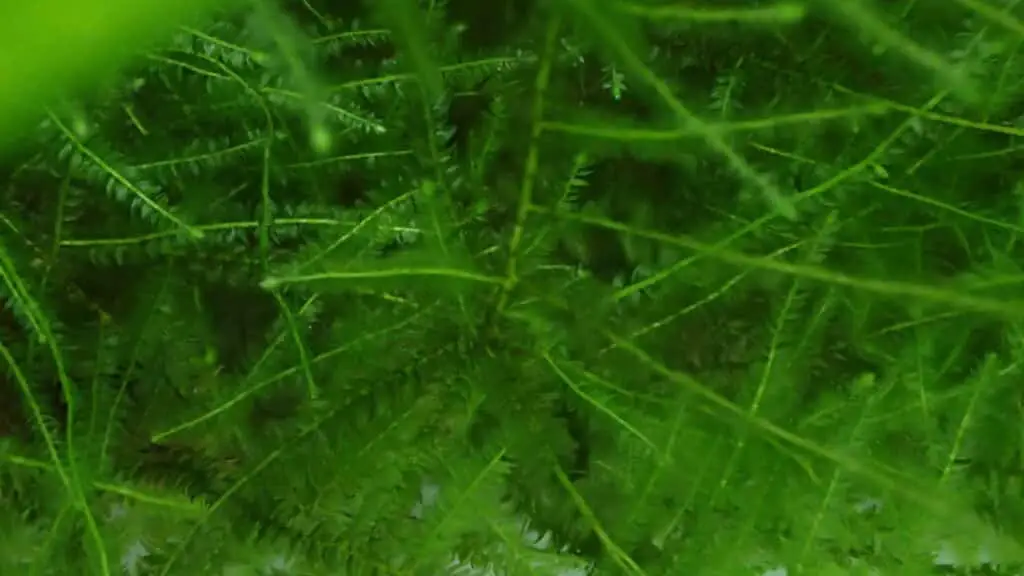
Removing String Algae from Java Moss
One common problem that hobbyists may encounter is the growth of string algae on their Java Moss. String algae can signal that the tank is not clean enough or lacks certain nutrients or minerals. When this happens, it is important to test your water parameters to determine the cause of the problem. If the water conditions are not ideal, correcting them should help to reduce the growth of string algae.
However, if the water parameters are within acceptable limits, the best way to remove string algae from Java Moss is to do it manually. Although this can be time-consuming, it is effective and can be done using a couple of barbeque skewers.
Simply wrap the skewer around the string algae and give it a sharp tug to remove it from the Java Moss. With patience and care, you can keep your Java Moss looking its best and free from string algae.
It’s important to note that while hydrogen peroxide (H2O2) is often used to treat algae in aquariums, it is not recommended for use on Java Moss by myself. H2O2 can be harsh and damaging to the plant and tends to burn delicate mosses like Java Moss.
If you’re experiencing an algae outbreak in your tank and need to remove it from your Java Moss, manually use a barbeque skewer or a similar tool. This method is effective and will help preserve the delicate structure and appearance of your Java Moss.

Pretreating Java Moss To Prevent Pests from Getting Into Your Tank
Java Moss can be susceptible to pests like snails, planaria, hydra, and leaches, hitchhiking a lift into your tank. To prevent these pests from taking over your Java Moss, it is recommended to pre-treat the plant with alum dip before introducing it to your tank. An alum dip is a simple and effective way to remove any unwanted pests and ensure that your Java Moss is free from contamination.
To perform an alum dip, mix a solution of aluminum sulfate (alum) and water according to the manufacturer’s instructions. Soak the Java Moss in the solution for a few hours, then rinse it thoroughly with clean water. The alum dip will help to kill any pests that may be present on the plant, ensuring that your Java Moss is free from contamination when you add it to your tank.
Alum, also known as aluminum sulfate, is a chemical compound that is commonly used in water treatment, dyeing, and baking. In the aquarium and pond hobby, it is often used to pre-treat plants like Java Moss to remove pests like snails, planaria, hydra, and leaches.
Alum can be found at most aquarium and pond supply stores, as well as online retailers and food shops. When purchasing alum, be sure to look for a high-quality product. Always ensure your product before adding it to a tank or treating something.
For more detailed information on performing an alum dip, you can visit our comprehensive article on the topic.
The High-Tech Setup for Java Moss
To create optimal conditions for Java Moss to grow and thrive, many hobbyists use a high-tech setup, including elements such as CO2 injection, a carefully crafted fertilization regimen, and high-intensity lighting.
The Benefits of a High-Tech Setup for Java Moss:
- CO2 injection: CO2 is essential for plant growth, and adding it to your tank can help to promote healthy and vigorous growth for your Java Moss.
- Fertilization regimen: A balanced fertilization regimen will give your plants the nutrients they need to grow and thrive.
- High-intensity lighting: High-intensity LED or metal halide lights often provide the intense lighting that Java Moss needs to grow and thrive.
- Active substrates: Nutrient-rich soil or clay-based substrates can also help to promote healthy growth and enhance the overall appearance of your Java Moss.
However, it’s important to remember that while a high-tech setup can provide optimal conditions for Java Moss, it may not always be the best choice for other inhabitants of your aquarium, particularly shrimp. Shrimp are delicate creatures that require stable water conditions to thrive, and a high-tech setup typically requires much larger water changes.
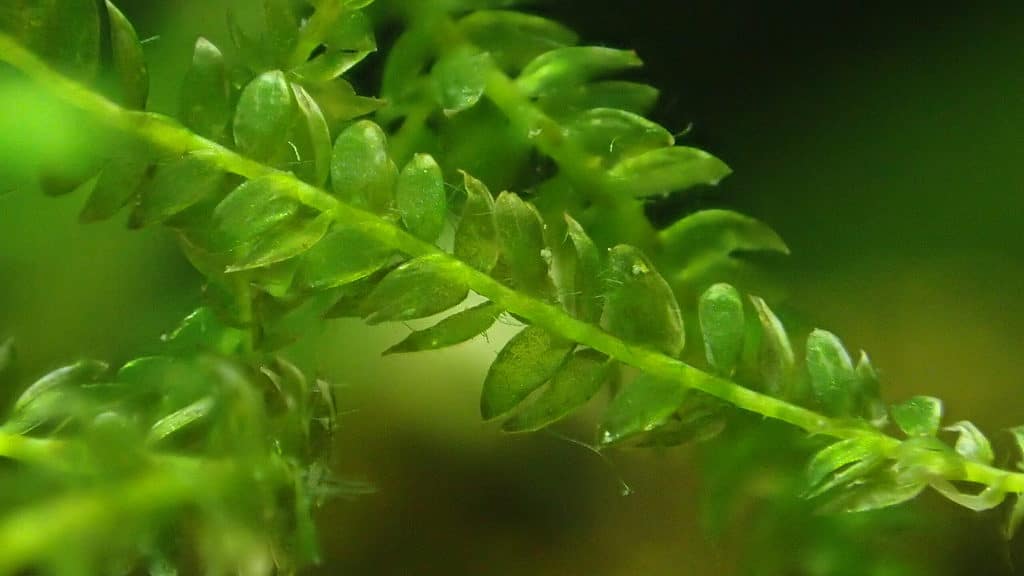
Other Mosses you Could Try
In addition to Java Moss, several other aquatic mosses are similar in appearance and care. Some of the most popular options include:
- Christmas Moss (Vesicularia montagnei): Christmas Moss is a slow-growing plant that forms a dense and attractive carpet. It has a similar texture to Java Moss, but its leaves are slightly larger and more rounded. Christmas Moss prefers moderate lighting and a temperature range of 72-82°F (22-28°C).
- Taiwan Moss (Taxiphyllum alternans): Taiwan Moss is a delicate and graceful plant that forms a dense, tangled mass of delicate leaves. It is similar to Java Moss in appearance and care, but prefers slightly warmer water temperatures, ranging from 72-82°F (22-28°C).
- Flame Moss (Taxiphyllum sp. “Flame”): Flame Moss is a slow-growing plant that forms a dense and attractive carpet. Its leaves are slightly smaller than Java Moss, and it has a somewhat more upright growth habit. Flame Moss prefers moderate lighting and a temperature range of 72-82°F (22-28°C).
When it comes to caring, all of these mosses have similar requirements to Java Moss. They prefer a neutral to slightly acidic pH range of 5.0-7.0 and moderate to high humidity. They are also relatively low-maintenance, requiring only occasional pruning and trimming to control their shape and size.
Conclusion
Java moss is a versatile and hardy plant that is easy to care for and provides many benefits to the plants and fish in your aquarium. Whether you want to float it on the surface, tie it to rocks or other decorations, or create a wall or carpet, Java moss is an excellent addition to any aquarium setup. With its attractive appearance and numerous benefits, it’s no wonder that Java moss is one of the most popular plants in the aquarium hobby.
Java Moss FAQ
Q: What is Java Moss? A: Java Moss is a species of aquatic plant that is commonly used in aquariums. It is known for its hardy nature and easy maintenance.
Q: What is the scientific name of Java Moss? A: The scientific name of Java Moss is Taxiphyllum barbieri.
Q: What are the benefits of using Java Moss in an aquarium? A: Java Moss provides several benefits to an aquarium, including improving water quality by absorbing excess nutrients and providing a natural environment for fish and other aquatic organisms.
Q: How do I care for Java Moss in an aquarium? A: Java Moss is a hardy plant that requires minimal care. It can be grown in a variety of aquarium setups and lighting conditions. It is important to keep it clean by removing any debris or algae that may accumulate on its surface.
Q: What is the ideal water temperature for Java Moss? A: The ideal water temperature for Java Moss is between 68-86 degrees Fahrenheit.
Q: Can Java Moss be grown without a substrate? A: Yes, Java Moss can be grown without a substrate by attaching it to rocks, driftwood, or other aquarium decorations.
Q: How do I attach Java Moss to aquarium decorations? A: Java Moss can be attached to aquarium decorations using fishing line, cotton thread, or glue. It is important not to use harmful chemicals or adhesives that may harm your fish or other aquatic organisms.
Q: How fast does Java Moss grow? A: Java Moss grows relatively slowly, but it can spread rapidly in favorable conditions. Regular pruning can help to control its growth and prevent it from becoming too invasive.
Q: Can Java Moss be propagated? A: Yes, Java Moss can be propagated by cutting off small pieces and attaching them to new surfaces. It can also be divided by gently separating clumps and replanting them.
Q: Can Java Moss be used to breed fish? A: Yes, Java Moss can be used as a spawning medium for some fish species, such as Betta fish. The plant provides a natural environment for fish to lay their eggs and for the fry to hide and feed.
